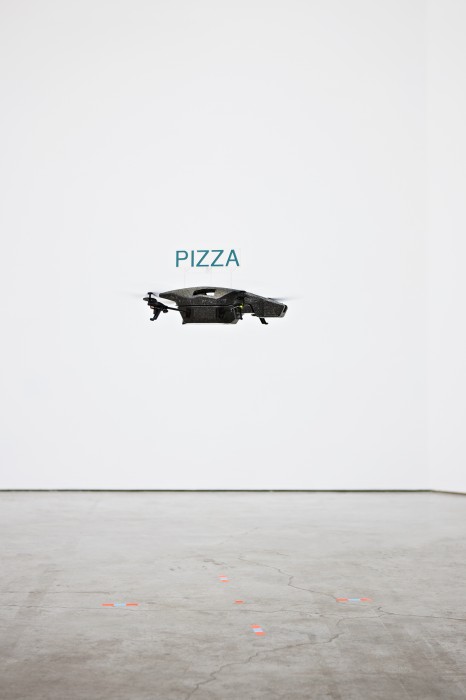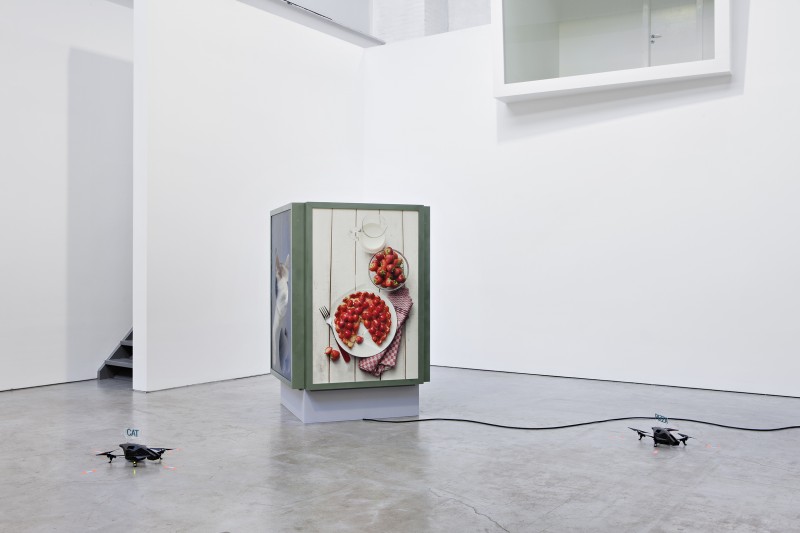Antoine Catala, Image Families, 2013
Antoine Catala’s solo show at Peep-Hole, titled “Heavy Words,” had a playful space-age feel, offering a holographic E.T., inflatable screens and flying drones. However, the work ultimately revealed more about our present—a world invaded by digital images—than any imagined future. The exhibition, produced in conjunction with FRAC Champagne-Ardenne and curated by its director, Florence Derieux, united three projects from 2013 that the French artist has shown separately but considers a trilogy. Each occupied its own room.
Located in the first gallery, Il était une fois (Once Upon a Time), which was presented at last year’s Lyon Biennale, is an installation using various technological devices (such as holograms and fog machines) to construct vignettes whose verbal counterparts form a rebus of the title. In the next gallery, Image Families consists of large prints on latex featuring subjects that fit into one of four categories—“cat,” “pizza,” “ass” and “car”—symbolically representing the most popular Internet image searches. The prints were mounted one per side on four tall, kiosklike structures, which concealed pump systems that made the latex surfaces expand and contract, as if the pictures were breathing. Several computer-controlled toy airplanes, referred to as “drones” by the artist, flew around the room. They would pause in front of various images, seeming to analyze their contents, while electronic voices announced the names of the objects at intervals. In addition, two large holograms—one of a cat, the other a car—inside black aluminum frames were complicated by moving images projected onto them. This installation metaphorically describes a common process in our digitized era of the production and consumption of images: you need only type a word into a search engine to conjure myriad images representing that word. The artist considers technological devices such as computers, smart phones and augmented reality tools as prostheses of the human body, and he has renamed them “machine-images.” Paraphrasing Baudrillard, real objects disappear, to be replaced by simulacra.
For Abracadabra, the artist used a 3-D printer to create sculptures of emoticons. Two works on the floor depict the symbols of a broken heart ((///)< ). Next to them a large aluminum structure supported a multicolored, silicone rubber butterfly; a 3-D pictogram recalling the shape of a butterfly; and an inflatable latex surface with the image of the butterfly pictogram against a cloudy sky. With this piece, as the title of the show announces, language loses its lightness and acquires material solidity. Any word indeed, thanks to computers and 3-D printers, can be translated into a real object.
As the artist explained to me, the three installations are intended to illustrate, in an allegorical manner, the equivalence between words, images and things that distinguishes our Internet age. The distinction between two and three dimensions—as the holograms in Image Families and the butterfly-shape sculptures in Abracadabra reveal, for instance—becomes malleable, while language takes on the power to mold a brand-new cosmos. Catala, through a bizarre and cryptic visual vocabulary, offers viewers an original semiological adventure.
Source: Contemporary Art Daily.
Text: Federico Florian, http://www.artinamericamagazine.com/reviews/antoine-catala/.
All images belongs to the respective artist and management.

